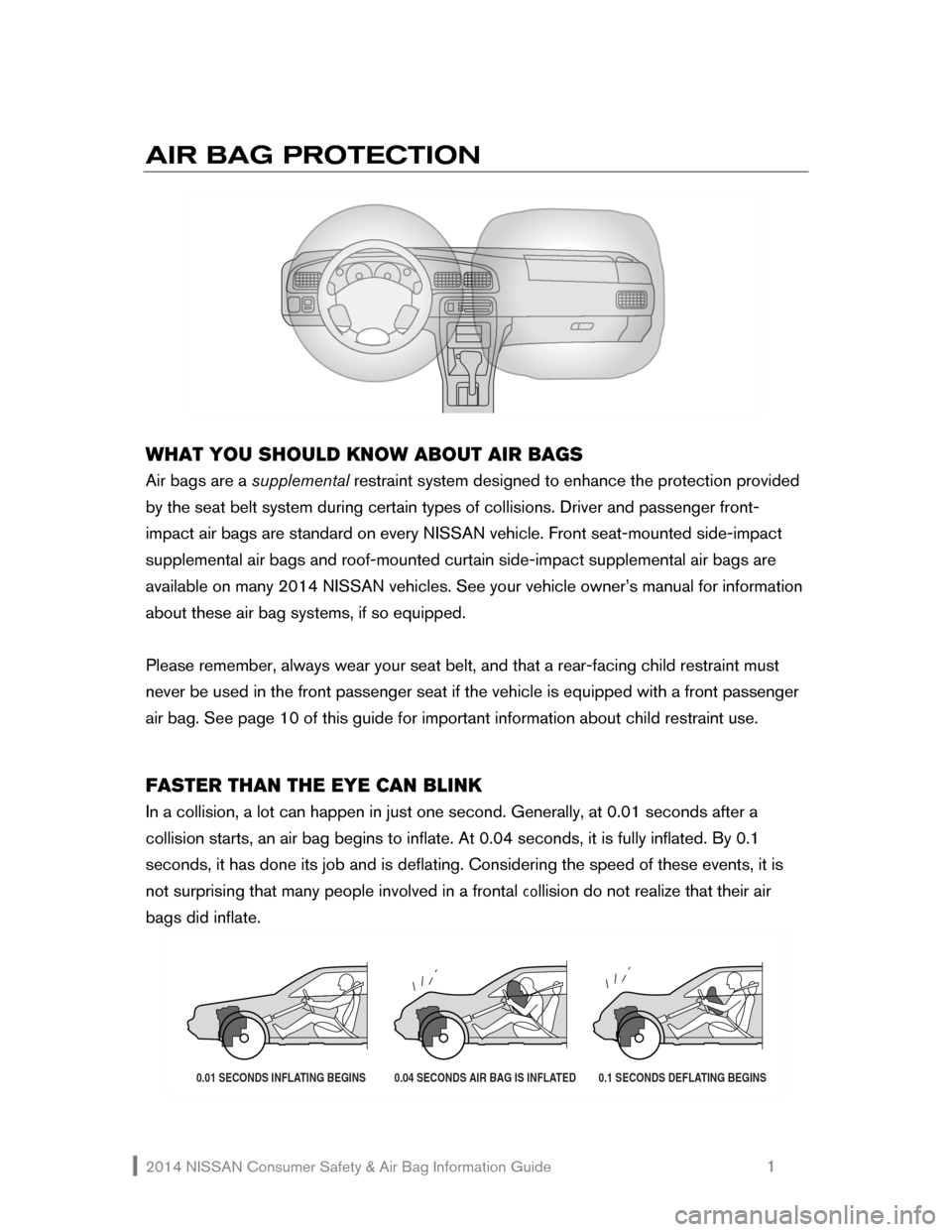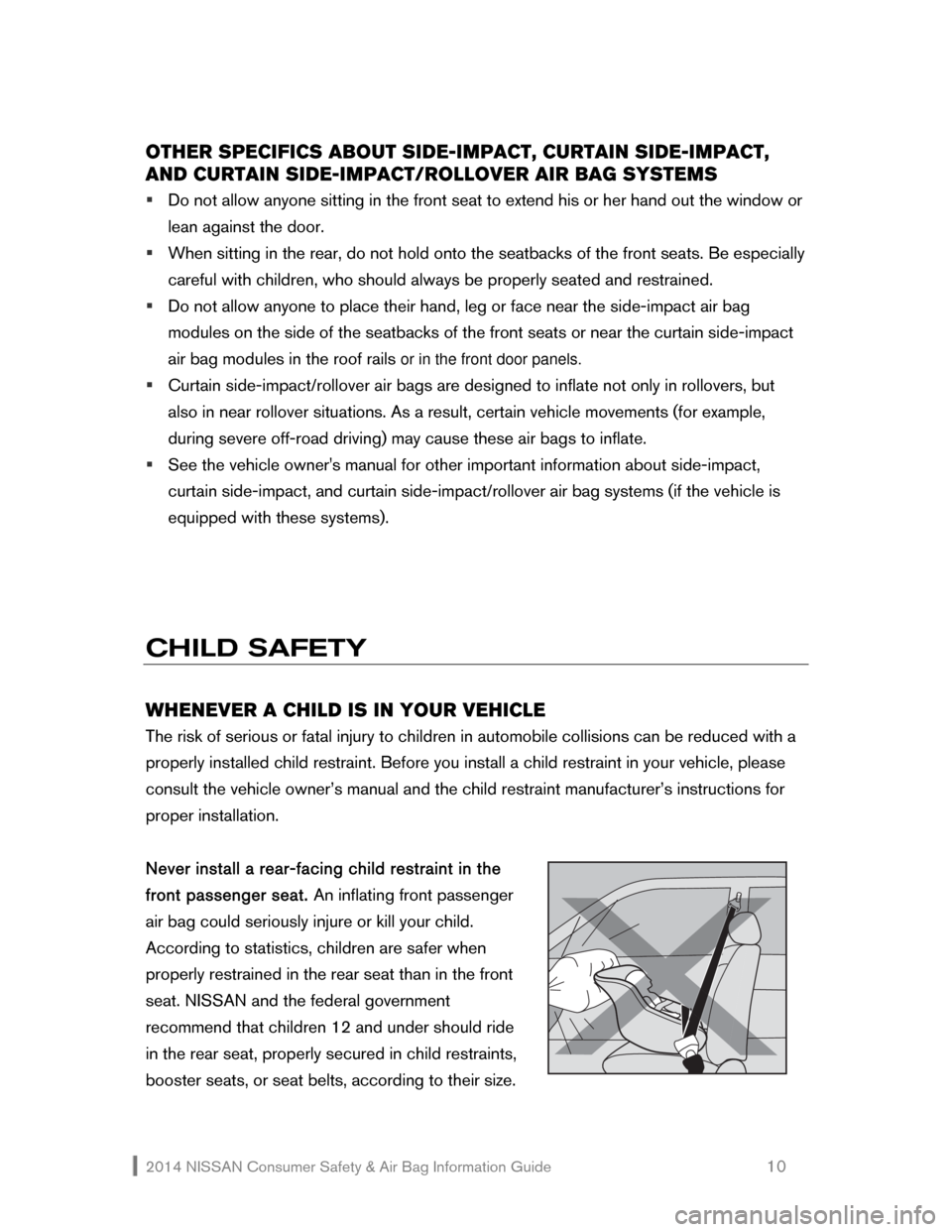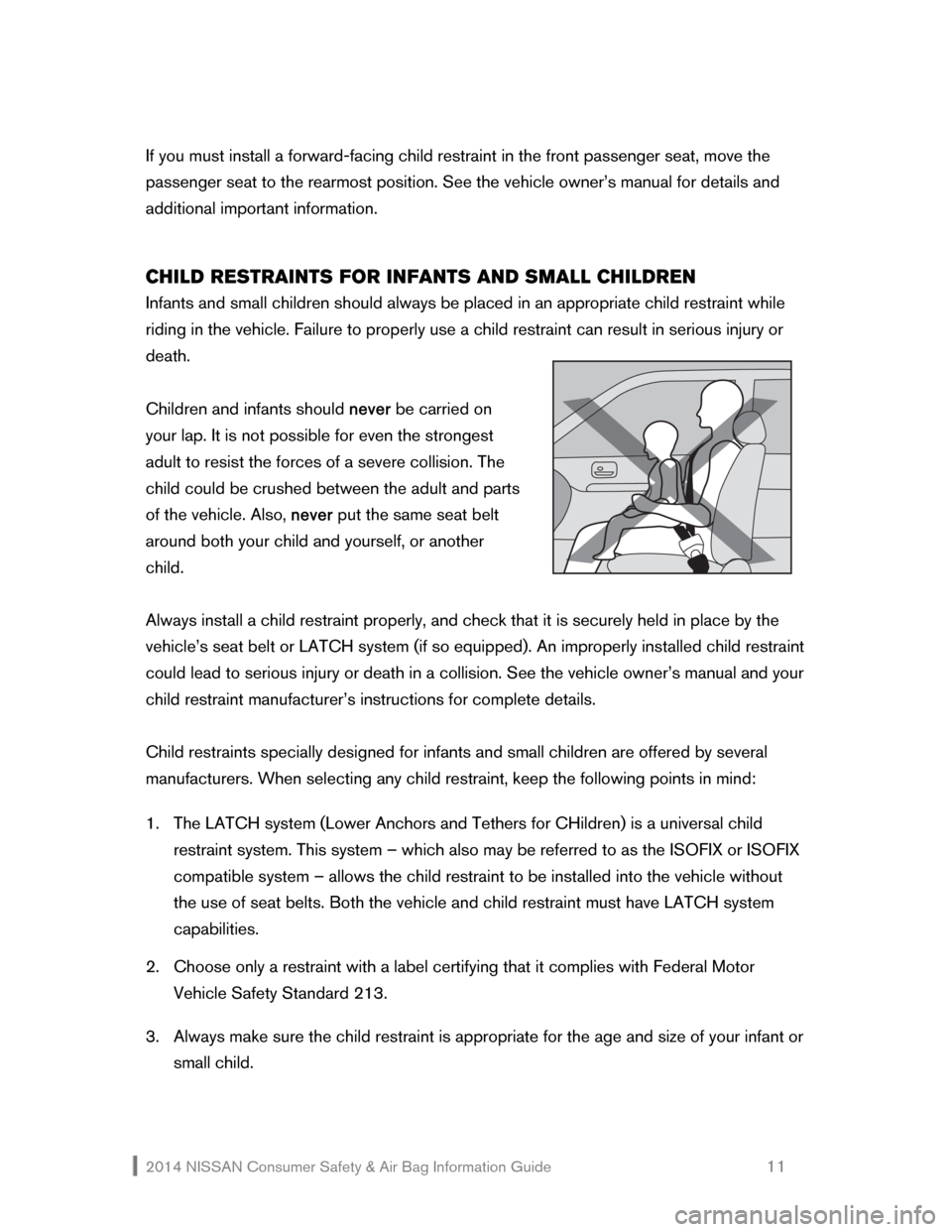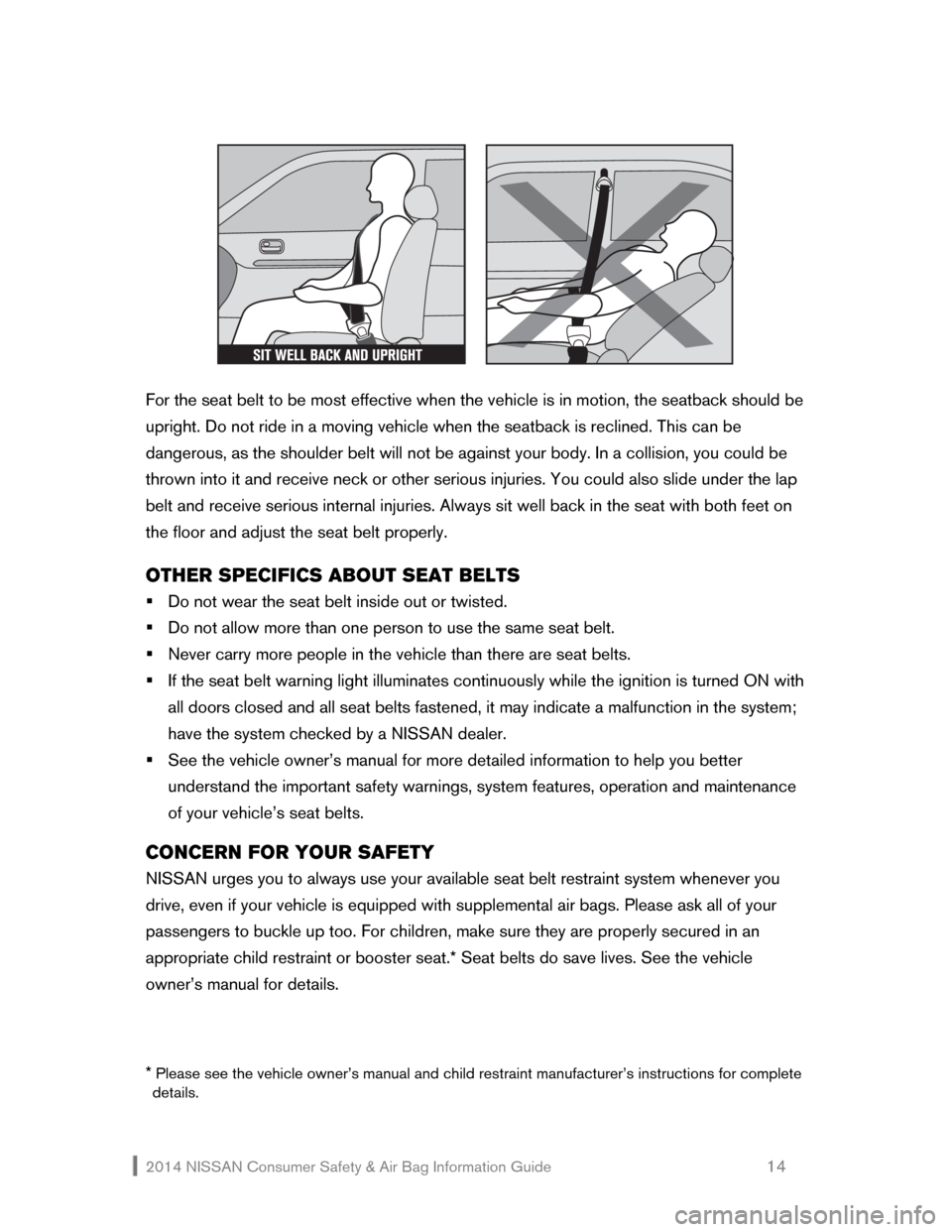2014 NISSAN TITAN child restraint
[x] Cancel search: child restraintPage 2 of 19

2014 NISSAN Consumer Safety & Air Bag Information Guide 1
AIR BAG PROTECTION
WHAT YOU SHOULD KNOW ABOUT AIR BAGS
Air bags are a supplemental restraint system designed to enhance the protection provided
by the seat belt system during certain types of collisions. Driver and passenger front-
impact air bags are standard on every NISSAN vehicle. Front seat-mounted side-impact
supplemental air bags and roof-mounted curtain side-impact supplemental air bags are
available on many 2014 NISSAN vehicles. See your vehicle owner’s manual for information
about these air bag systems, if so equipped.
Please remember, always wear your seat belt, and that a rear-facing child restraint must
never be used in the front passenger seat if the vehicle is equipped with a front passenger
air bag. See page 10 of this guide for important information about child restraint use.
FASTER THAN THE EYE CAN BLINK
In a collision, a lot can happen in just one second. Generally, at 0.01 seconds after a
collision starts, an air bag begins to inflate. At 0.04 seconds, it is fully inflated. By 0.1
seconds, it has done its job and is deflating. Considering the speed of these events, it is
not surprising that many people involved in a frontal
collision do not realize that their air
bags did inflate.
0.01 SECONDS INFLATING BEGINS 0.04 SECONDS AIR BAG IS INFLATED 0.1 SECONDS DEFLATING BEGINS
Page 3 of 19

2014 NISSAN Consumer Safety & Air Bag Information Guide 2
THE NISSAN ADVANCED AIR BAG SYSTEM
All 2014 NISSAN vehicles (except for the 2014 NV 1500/2500/3500*) are equipped with
the NISSAN Advanced Air Bag System (AABS) for the driver and front passenger seats.
Typically, this system, which has dual-stage inflators,** monitors information from various
crash sensors, the front seat belt buckle sensors, and the occupant classification sensor.
The front passenger air bag may automatically turn OFF under some conditions, depending
on the pressure or weight detected by sensors in the passenger seat. See the vehicle
owner’s manual for more information. If the front passenger air bag is OFF, the front
passenger air bag status light will be illuminated.***
The front passenger air bag status light does not indicate a malfunction of the front
passenger air bag. If the front passenger air bag status light is illuminated while a small
adult, child, or child restraint occupies the seat, the occupant may need to shift his or her
seating position, or remove the child restraint so the system can turn ON the front
passenger air bag and turn off the status light.
THE MOST IMPORTANT PART OF AN AIR BAG: YOUR SEAT BELT
Your chances of surviving a collision will improve greatly if one simple piece of advice is
followed: always wear your seat belt. Remember, all air bags are supplemental restraint
systems. Do not count on just the air bags for occupant protection; they are merely a
supplemental restraint system. You must always use seat belts properly, as explained in
the vehicle owner’s manual.
Seat belts help to protect the occupants of your vehicle during collisions in which the air
bags are not designed to activate. Moreover, in situations where the air bags are activated,
seat belts enhance their effectiveness and can help reduce the risk of injury from an
inflating air bag. Seat belts will also help protect the occupants of your vehicle during
multiple-impact collisions, while the air bags work only one time if a collision is severe
enough to activate them. Please see the SEAT BELT SAFETY and CHILD SAFETY
sections of this guide and the vehicle owner’s manual for more information.
*
The NV lineup is equipped with dual-stage front air bags and seat belt buckle sensors, but the
2014 NV 1500/2500/3500 does not have an occupant classification sensor (and the associated
front passenger air bag status light).
**Dual-stage inflators vary the air bag inflation rate based on the severity of the collision (for
example, less
forceful inflation for moderate impacts and a high force of inflation for more severe impacts). In
addition, based on information from the seat belt buckle sensors that detect whether the seat belts
are fastened, whether one or both front airbags deploy. Only one front air bag may inflate in a
crash, depending on the crash severity, and whether the front occupants are belted or unbelted.
***When the system detects that the seat is unoccupied, the passenger air bag status light will not
illuminate even though the front passenger air bag is OFF.
Page 5 of 19

2014 NISSAN Consumer Safety & Air Bag Information Guide 4
collisions, rear-end collisions, rollovers, while driving on rough roads, or during hard
braking. However, deceleration rates in some situations can be similar to those found in
frontal impacts and may result in front air bag activation.
WHEN THE FRONT AIR BAGS INFLATE
Please remember, for the supplemental front air bags to be most effective, you must always
buckle up and be seated upright and well back in the seat away from the steering wheel or
instrument panel to allow room for the air bags to inflate. For the front air bags to do their
job, they must inflate with great force. As mentioned earlier in this guide, this may cause
serious or even fatal injury if, for example, you are unrestrained out of position in any way,
sitting or leaning too close to the steering wheel or instrument panel during inflation. Even
when seated properly, there is a possibility of injury from an inflating front air bag. This
usually consists of minor skin abrasions or burns, but may be more serious. Overall, these
injuries are minimal compared to the injuries the front air bags are designed to prevent.
After the front air bags have inflated, you may notice a light smoke within the cabin. This is
a normal by-product of the rapid chemical reaction necessary to inflate the front air bags
and, although harmless do not inhale it, it may cause irritation and choking.
REPLACING THE AIR BAGS
Air bags are not reusable. After a collision in which your air bags have activated,
have the respective air bag system inspected and replaced by your NISSAN dealer
as soon as possible. The National Highway Traffic Safety Administration (NHTSA)
has expressed concern regarding reports of counterfeit replacement air bags
installed in vehicles. Visit www.nhtsa.gov
for more information. We recommend the
replacement of air bags by your NISSAN dealer to ensure that you receive new
original equipment replacement parts. Counterfeit replacement air bags may not
be made to the standards of quality, reliability and durability of Genuine NISSAN
parts. The use of counterfeit replacement air bags or used or salvaged air bags is
a potential serious safety problem and may not provide the same level of protection
in a crash.
OTHER SPECIFICS ABOUT AIR BAGS
�ƒ If the air bag warning light continues to remain on or flashes after you start the vehicle,
see your NISSAN dealer as soon as possible.
�ƒ After inflation, air bag components are hot, so avoid contact.
�ƒ Do not place objects on or near the steering wheel or instrument panel where the air
bags inflate.
�ƒ Child restraints for infants must be used in a rear-facing direction and therefore
must not be used in the front seat. Never install a rear-facing child restraint in the
front passenger seat of a vehicle equipped with a front passenger air bag.
�ƒ See the vehicle owner’s manual for other important information.
WELL BACK AND UPRIGHT
Page 11 of 19

2014 NISSAN Consumer Safety & Air Bag Information Guide 10
OTHER SPECIFICS ABOUT SIDE-IMPACT, CURTAIN SIDE-IMPACT,
AND CURTAIN SIDE-IMPACT/ROLLOVER AIR BAG SYSTEMS
�ƒ Do not allow anyone sitting in the front seat to extend his or her hand out the window or
lean against the door.
�ƒ When sitting in the rear, do not hold onto the seatbacks of the front seats. Be especially
careful with children, who should always be properly seated and restrained.
�ƒ Do not allow anyone to place their hand, leg or face near the side-impact air bag
modules on the side of the seatbacks of the front seats or near the curtain side-impact
air bag modules in the roof rails
or in the front door panels.
�ƒ Curtain side-impact/rollover air bags are designed to inflate not only in rollovers, but
also in near rollover situations. As a result, certain vehicle movements (for example,
during severe off-road driving) may cause these air bags to inflate.
�ƒ See the vehicle owner's manual for other important information about side-impact,
curtain side-impact, and curtain side-impact/rollover air bag systems (if the vehicle is
equipped with these systems).
CHILD SAFETY
WHENEVER A CHILD IS IN YOUR VEHICLE
The risk of serious or fatal injury to children in automobile collisions can be reduced with a
properly installed child restraint. Before you install a child restraint in your vehicle, please
consult the vehicle owner’s manual and the child restraint manufacturer’s instructions for
proper installation.
Never install a rear-facing child restraint in the
front passenger seat. An inflating front passenger
air bag could seriously injure or kill your child.
According to statistics, children are safer when
properly restrained in the rear seat than in the front
seat. NISSAN and the federal government
recommend that children 12 and under should ride
in the rear seat, properly secured in child restraints,
booster seats, or seat belts, according to their size.
Page 12 of 19

2014 NISSAN Consumer Safety & Air Bag Information Guide 11
If you must install a forward-facing child restraint in the front passenger seat, move the
passenger seat to the rearmost position. See the vehicle owner’s manual for details and
additional important information.
CHILD RESTRAINTS FOR INFANTS AND SMALL CHILDREN
Infants and small children should always be placed in an appropriate child restraint while
riding in the vehicle. Failure to properly use a child restraint can result in serious injury or
death.
Children and infants should never be carried on
your lap. It is not possible for even the strongest
adult to resist the forces of a severe collision. The
child could be crushed between the adult and parts
of the vehicle. Also, never put the same seat belt
around both your child and yourself, or another
child.
Always install a child restraint properly, and check that it is securely held in place by the
vehicle’s seat belt or LATCH system (if so equipped). An improperly installed child restraint
could lead to serious injury or death in a collision. See the vehicle owner’s manual and your
child restraint manufacturer’s instructions for complete details.
Child restraints specially designed for infants and small children are offered by several
manufacturers. When selecting any child restraint, keep the following points in mind:
1. The LATCH system (Lower Anchors and Tethers for CHildren) is a universal child
restraint system. This system – which also may be referred to as the ISOFIX or ISOFIX
compatible system – allows the child restraint to be installed into the vehicle without
the use of seat belts. Both the vehicle and child restraint must have LATCH system
capabilities.
2. Choose only a restraint with a label certifying that it complies with Federal Motor
Vehicle Safety Standard 213.
3. Always make sure the child restraint is appropriate for the age and size of your infant or
small child.
Page 13 of 19

2014 NISSAN Consumer Safety & Air Bag Information Guide 12
4. Check the child restraint in your vehicle to be sure it is compatible with the vehicle’s
seat and seat belt system.
5. If the child restraint is compatible with your vehicle, place your child in the child
restraint and check the various adjustments to be sure the child restraint is compatible
with your child. Always follow all recommended procedures.
All U.S. states require that infants and small children be restrained in a certified child
restraint at all times while the vehicle is being operated.
THE LATCH SYSTEM (LOWER ANCHORS AND TETHERS FOR
CH
ILDREN)
Most 2014 NISSAN vehicles are equipped with universal child restraint lower anchors and
top tether anchors for the installation of child restraints equipped with LATCH attachments.
With this system, you do not have to use a vehicle seat belt to secure the child restraint.
Instead, special anchor points are utilized to install the child restraint, provided it is
compatible with the LATCH system. See the vehicle owner’s manual for child restraint
instruction details and additional important information.
SNUG KIDS™
The first of its kind, Snug Kids™ is our online guide to selecting a child restraint seat for
your NISSAN vehicle. Our Certified Child Passenger Safety Technicians
have evaluated
numerous child restraint seats and have compiled their findings to create the Snug Kids™
Child Safety Seat Fit Guides. These guides include important tips on correct installation
procedures. Visit www.NISSANUSA.com/snugkids to view or download the latest guide
information for finding a child restraint system that is right for your Nissan vehicle.
Page 15 of 19

2014 NISSAN Consumer Safety & Air Bag Information Guide 14
For the seat belt to be most effective when the vehicle is in motion, the seatback should be
upright. Do not ride in a moving vehicle when the seatback is reclined. This can be
dangerous, as the shoulder belt will not be against your body. In a collision, you could be
thrown into it and receive neck or other serious injuries. You could also slide under the lap
belt and receive serious internal injuries. Always sit well back in the seat with both feet on
the floor and adjust the seat belt properly.
OTHER SPECIFICS ABOUT SEAT BELTS
�ƒ Do not wear the seat belt inside out or twisted.
�ƒ Do not allow more than one person to use the same seat belt.
�ƒ Never carry more people in the vehicle than there are seat belts.
�ƒ If the seat belt warning light illuminates continuously while the ignition is turned ON with
all doors closed and all seat belts fastened, it may indicate a malfunction in the system;
have the system checked by a NISSAN dealer.
�ƒ See the vehicle owner’s manual for more detailed information to help you better
understand the important safety warnings, system features, operation and maintenance
of your vehicle’s seat belts.
CONCERN FOR YOUR SAFETY
NISSAN urges you to always use your available seat belt restraint system whenever you
drive, even if your vehicle is equipped with supplemental air bags. Please ask all of your
passengers to buckle up too. For children, make sure they are properly secured in an
appropriate child restraint or booster seat.* Seat belts do save lives. See the vehicle
owner’s manual for details.
* Please see the vehicle owner’s manual and child restraint manufacturer’s instructions for complete
details.